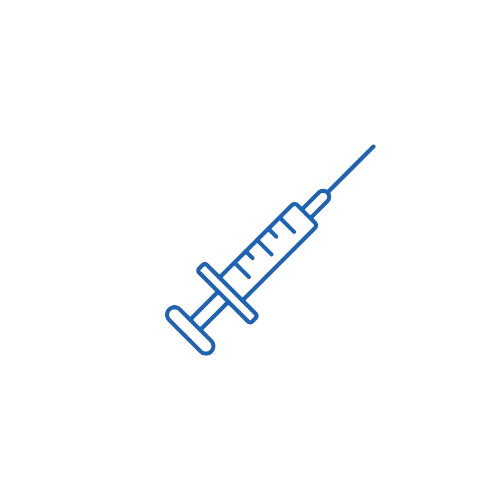Human Anti-D Immunoglobulins
Allopathic
Indications
- Prevention of Hemolytic Disease of the Newborn (HDN)
- Administered to Rh-negative pregnant women to prevent maternal sensitization to Rh-positive fetal red blood cells, reducing risk of hemolytic disease in current and future pregnancies.
- Routine antenatal prophylaxis at 28 weeks of gestation and postpartum if the newborn is Rh-positive.
- Treatment of Rh incompatibility-related complications
- Prevention of sensitization after spontaneous or induced abortion, ectopic pregnancy, miscarriage, or amniocentesis in Rh-negative women.
- Immune thrombocytopenic purpura (ITP)
- Used in select Rh-positive patients with ITP to increase platelet counts through immunomodulatory mechanisms.
- Off-label/adjunct uses
- Post-transfusion prophylaxis in Rh-negative patients receiving Rh-positive blood components.
Dosage & Administration
Administered intramuscular (IM); intravenous (IV) use reserved for special clinical situations.
- Antenatal prophylaxis
- Standard dose: 300 µg (1500 IU) IM at 28 weeks gestation in a singleton pregnancy.
- Dose may be increased in cases of twin pregnancy or significant fetomaternal hemorrhage.
- Postpartum prophylaxis
- If the newborn is Rh-positive: 300 µg IM within 72 hours of delivery.
- After miscarriage, abortion, ectopic pregnancy, or invasive procedures
- <12 weeks gestation: 50 µg IM
- ≥12 weeks gestation: 150 µg IM
- ITP management
- Dose varies: typically 50–75 µg/kg IV, may repeat based on platelet response.
- Special populations
- No standard adjustments required for renal or hepatic impairment.
- Elderly dosing is not typically required outside standard prophylaxis.
Mechanism of Action (MOA)
Anti-D immunoglobulin contains IgG antibodies specific for the Rh D antigen. When administered to an Rh-negative individual exposed to Rh-positive red blood cells, these antibodies bind to fetal Rh-positive erythrocytes, promoting their rapid clearance by the maternal reticuloendothelial system before the maternal immune system can become sensitized. This prevents the formation of maternal anti-D antibodies that could cross the placenta in future pregnancies and cause hemolysis in Rh-positive fetuses. In ITP, Anti-D binds Rh-positive red blood cells, diverting splenic macrophages away from platelets, resulting in increased platelet survival.
Pharmacokinetics
- Absorption: Rapid systemic availability following IM injection; peak plasma concentrations reached within 24–48 hours.
- Distribution: Primarily confined to the intravascular compartment; binds selectively to Rh-positive red blood cells.
- Metabolism: Catabolized into amino acids and peptides by the reticuloendothelial system; no hepatic enzyme metabolism involvement.
- Excretion: Eliminated through the natural turnover of red blood cells; IgG half-life approximately 21–28 days.
- Onset of action: Immediate binding to circulating Rh-positive cells; protective effect lasts several weeks.
Pregnancy Category & Lactation
- Pregnancy: Category C; indicated specifically for prophylaxis in Rh-negative pregnant women. Administration is safe when used according to recommended protocols.
- Lactation: Anti-D IgG is minimally excreted in breast milk and not expected to harm the infant. Caution is advised in extremely preterm or immunocompromised infants.
Therapeutic Class
- Primary therapeutic class: Immunoglobulin / blood product.
- Subclass: Rh immunoprophylactic agent.
Contraindications
- Known hypersensitivity to human immunoglobulins or excipients.
- Severe IgA deficiency with antibodies against IgA (risk of anaphylaxis).
- History of anaphylactic reaction to any blood-derived product.
- Rh-positive individuals (prophylactic use only in Rh-negative).
Warnings & Precautions
- Anaphylaxis: Rare but life-threatening; monitor for signs of hypersensitivity during and after injection.
- Hemolysis: High doses may rarely cause mild transient hemolysis; observe for pallor or jaundice.
- Thrombosis risk: Rare in patients with underlying cardiovascular disease.
- Use in ITP: Monitor platelet counts; risk of hemolytic anemia exists.
- Viral safety: Product derived from human plasma; ensure use of virus-inactivated preparations.
- Splenic sequestration: Monitor in ITP patients receiving high doses intravenously.
Side Effects
- Common
- Injection site pain, swelling, or erythema.
- Mild fever, headache, or fatigue.
- Less common / serious
- Allergic reactions: urticaria, rash, anaphylaxis.
- Mild hemolysis, jaundice, or transient anemia.
- Rare thromboembolic events in high-risk patients.
- Dose-dependence
- Higher doses increase risk of hemolysis; IV administration carries higher risk of systemic adverse reactions.
Drug Interactions
- Other immunoglobulins: May interfere with live attenuated vaccines; defer vaccination for up to 3 months post-administration.
- Live vaccines: Antibody-containing preparations may reduce efficacy of rubella, measles, and varicella vaccines.
- No significant CYP450 interactions: Protein-based therapy, metabolized via reticuloendothelial system.
Recent Updates or Guidelines
- WHO, ACOG, and RCOG recommend routine prophylaxis for all Rh-negative pregnant women at 28 weeks gestation and post-delivery if newborn is Rh-positive.
- Dose standardization: Updated protocols suggest 300 µg IM as standard antenatal and postpartum dose.
- High-risk pregnancies: Dosage may be increased for multiple gestation or fetomaternal hemorrhage.
- Emphasis on using recombinant or highly purified plasma-derived products to reduce infection risk.
Storage Conditions
- Temperature: Store 2°C–8°C (refrigerate); do not freeze.
- Light & humidity: Protect from light; store in original packaging.
- Handling precautions: Use sterile technique for injection; inspect solution before administration.
- Reconstitution: Pre-filled vials are typically ready-to-use; lyophilized preparations must be reconstituted with sterile diluent immediately prior to administration.
- Shelf life: Follow manufacturer’s expiration dates; discard any unused reconstituted solution as recommended.

